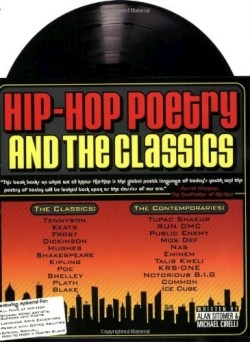Hip-Hop Poetry and the Classics
Teachers looking for ways to bring students into the world of poetry now have help. The author is a novelist, playwright, screenwriter, and greeting card author, and he was named California’s Teacher of the Year for his work as an inner-city high school teacher in Los Angeles. He combines his pedagogical skills with the spoken-word poetry savvy of Cirelli, a National Poetry Slam finalist who has published his work in journals and anthologies, performed all over the United States and Canada, and taught writing workshops on the West Coast and in New York City. Their book looks closely at classical poetry and hip-hop lyrics, providing a space in the classroom for the students to enter into poetry without losing sight of their own identities.
Split into lessons, the book often begins with a classical poem, such as “Do Not Go Gentle Into That Good Night,” then supplies questions that will help the students to identify and analyze primary themes or techniques within the work. Then, the authors pair the classical with a contemporary piece that shares like themes or approaches, like a poem by late rapper Tupac Shakur. Students see that poets can be in conversation with each other over the course of centuries, across nationalities and circumstances, and that poets, regardless of gender, age, ethnicity, or income, can share emotions and responses.
The selections for the book are varied, ranging from Shakespeare and Elizabeth Bishop to Mos Def and Eminem. The book does not shy away from discussions of race, as with a lesson that questions Vachel Lindsay’s controversial poem, “The Congo.” Some of the classic poems have been drastically cut without any acknowledgement that students are not reading the full piece, and the analysis does not fully integrate the terms of poetics, though they would certainly apply to rap lyrics as well.
The book does provide more than twenty-five student worksheets and fifteen writing exercises, encouraging students to find their own voices, so it could be used throughout the school year. The “Additional Poetic Resources” section suggests ideas for other ways to incorporate poetry into the lives of students, including instructions for hosting poetry slams, AP exam strategies, recitation exercises, gifted and talented options, ESL approaches, and a series of other writing activities. The volume finishes with a useful appendix featuring a glossary of terms and the California Language Arts Standards.
For junior high and high school teachers who struggle with strategies for teaching poetry, this book provides an easy entrance; however, teachers will want to augment it by showing the way in which the knowledge the book provides will build with each lesson. By the end of the book, students should have a working critical vocabulary for poetry analysis and an understanding of the connection between oral traditions of the present and the past.
Reviewed by
Camille-Yvette Welsch
Disclosure: This article is not an endorsement, but a review. The publisher of this book provided free copies of the book to have their book reviewed by a professional reviewer. No fee was paid by the publisher for this review. Foreword Reviews only recommends books that we love. Foreword Magazine, Inc. is disclosing this in accordance with the Federal Trade Commission’s 16 CFR, Part 255.

